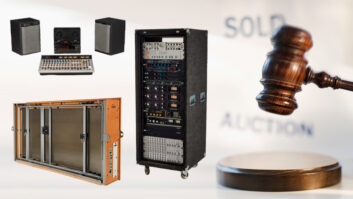
Student Tom Colin operates the (very analog) 3M M80 4-track prototype that was rescued from a resale shop.
Photo: David Hedding
An audio education is a partnership between the school and the student. The school provides educational opportunities. The student must be ready to invest time and energy to get educated and not simply waste parental or governmental “fundage.”
Reality Check
The success of each class is determined by the instructor’s ability to assess students’ abilities and move at a pace that keeps the quick learners engaged and the challenged learners from falling too far behind. (In jazz, this is referred to as “improvising.”) This is particularly applicable to teaching Studio Maintenance, an introduction to electronics. This class often reveals how little math the students have absorbed and retained from high school as well as how different a mouse is from needle-nosed pliers.
In addition to Studio Maintenance, I alternately teach Analog Technology, a recording class that emphasizes the “discipline of minimalism,” starting on 4-track half-inch. These days, analog recording is now so far from the norm that it’s become an exotic art form. An added plus, mic preamps built in the electronics class often get used in the “analog” class.
Needle Drop
Day one in Analog Technology begins with listening to a wide range of recordings, from vinyl sources whenever possible. “The analog sound,” in my opinion, was dictated both by the minimalist skills that engineers honed on their way to success, along with the challenge of conforming their mixes to what was do-able on vinyl. Any sonic “thing” can be put anywhere on a CD, but on vinyl, every inch toward the spindle is more of an obstacle course for the stylus to negotiate.
Once acquainted with vintage sensibilities, the class then chooses a path based on available talent. We’ve recorded pop classics from the 4-track era as well as original material. Nothing says “discipline” like committing a handful of drum mics to one track, after which everyone wants to attribute our cool sounds to analog tape. But those in the control room know it sounded good before playback — you can make a bad recording no matter what the medium is, analog or digital.
New School
It’s much too easy to set up as many mics around a drum kit as possible and hope for the best. I explain that these techniques evolved as part of an insurance policy — to accommodate all sorts of drumming styles and worst-case scenarios, like providing sample triggers when all else fails. That’s fine as far as it goes, but it doesn’t teach young drummers to be consistent and it doesn’t teach mic technique. If you are only hearing three mics, each one is critical.
We spend more time tuning and trying different drums and damping tricks, then watch and listen to how differently the drummer plays. After applying “doorags” to the toms and snare, the drummer immediately started playing the Beatles’ “Come Together,” and the band didn’t miss a beat, jumping right in. As much as luck favors the prepared, alternative ideas inspire students to be more creative with less. This is how a sonic foundation is built.
Our emphasis is on ensemble playing — including overdubs — all to minimize the number of bounces and tracks. We’ve employed many of the old tricks, like live overdubs while bouncing, using the lobby for its natural reverb, a tape machine for pre-delay and 100 percent real flanging. The ability to express emotion by controlling a purely analog effect is priceless.
Let the Music Play On
By the second half of the quarter, the students go 24-track, albeit with an undersized mixer of 12 to 16 inputs. Limiting the rhythm tracks to that amount maintains the discipline factor. We then do a stereo submix to make room for the overdubs, forcing the students to think ahead, just like when recording to 4-track. Thanks to excellent players, we’ve often accomplished this with tracks to spare.
Our most ambitious project was to bring in a local band, Hookers and Blow, that specializes in “music from a more permissive era,” classic soul and R&B from the ’60s and ’70s.
Five or six tracks were used for drums, a mic for each guitar (Cascade Fathead and Sennheiser e609), SM58 on bass, Cascade Fathead on horns, DI for keys (one or two tracks), RCA “Junior” ribbon mic on slide/lap steel guitar, and Nady TCM 1050 in omni for the lobby/reverb. Lead vocals were recorded live for cover versions of Sly Stone’s “If You Want Me to Stay” and The Band’s “Life Is a Carnival.” In four sessions, the rhythm tracks and overdubs amounted to an album’s worth a material, driving home the point that our crew had to keep one step ahead of the band on every front — track sheets, session log and last-minute mic changes.
Great players allowed us to get away with fewer mics and tracks, while focusing on mic choice, placement and the music. Not worrying about absolute isolation allowed the type of leakage that was common on records into the ’70s, which is part of the magic that can’t be duplicated after the fact.
Boxed Lunch
Mixing on an analog console without automation requires some rehearsal, but is faster than mixing in the box because feel takes priority over perfection. Understand that I like mixing in the box. I’m not romancing an old flame, but it is a reminder to think outside the box — you gotta get out and stretch those legs, fingers, ears and ideas. The 24-track sessions were digitized for student access and became the most enthusiastically received homework assignment ever. Sometimes homework isn’t so bad after all.
Check out some of our class samples. Analog rough mixes are at www.tangible-technology.com/ipr/AE240/winter_08/HnB_songs.html. In the box mixes are at www.tangible-technology.com/music/HnB/Boxed-Lunch.html.
Visit Eddie Ciletti:
www.tangible-technology.com.
AUDIO SCIENCE
Early Education
Kids can begin learning the basics of audio technology as early as middle school. During the middle- and high-school years, alternative, hands-on classes with a tangible connection to music and to “real life” can help engage kids who otherwise might tune out in the classroom.
I’ve taught “mini” audio and video technology classes to fourth graders. One day I had the total attention of 10 students while explaining video camera basics. That teachable moment lasted all of 15 minutes until I handed out the cameras and lost control of the class! I have since learned to withhold class materials until I’ve explained all of my points, even for the 19- to 29-year-old demographic.
I was surprised at how quickly the tween scene got video editing, though they ignored my instructions to zoom out and get close. (Everybody wants to zoom, but that rarely results in a Dramamine-free video experience.) In contrast, audio recording and production seemed to present a much greater challenge. Kari Peterson, a music educator at our nearby grade school, Somerset Elementary, says that music and audio are much more abstract concepts than video editing. Apparently, the transition between concrete and abstract thinking begins around age 12. (See link below.)
The ability to set up for a multitrack recording and mix it well requires fundamental knowledge and educated ears — the ability to listen critically and analyze accurately. These are acquired skills. The fundamentals can be taught, but the rest is the graduate’s work-in-progress.
Link:
http://tip.psychology.org/piaget.html. Psychologist Jean Piaget (1896-1980) established four human development stages: Sensorimotor (birth to 2 years), Preoperational (2 to 7), Concrete (logical) Operational (7 to 11) and Formal Operational (the development of abstract reasoning, after age 11).
— Eddie Ciletti







